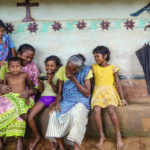Bhil Pithora artist Shanta Bhuriya of Jhabua, Madhya Pradesh talks about her life as an artist – in her own words.
The unique feature of the Bhil Pithora art is the use of small dots to depict anything one wishes to portray.
I let my creativity run free while initially drawing with pencil.
Whenever I bring nature alive on canvas, I try to depict the peacock differently, fired by my imagination.
Bright colours make my paintings stand out, especially the trees and animals.
It is also the best way to spread environmental awareness.
Bhil Pithora art was common in Jhabua where I was born and also in Barwani district.
I learnt the art from my famous mother Bhuri Bai. She’s a Padma Shri recipient as you may know.
In my mother’s time the paintings adorned the mud walls of rural houses during festivals and weddings.
Cow dung was applied first for smoothness. They made their own paints using crushed leaves and turmeric paste. Natural colours lend a unique charm to mud walls.
Now such mud walls are hard to find. Naturally, the paintings have almost disappeared.
But it is a good thing that the art has found its way to canvas and paper or else it would have disappeared by now. A handful of painters is keeping the art alive.
My mother is one of them.
The hands that hold the brush today did manual labour once. It’s a good thing that she never stopped painting even though she moved from Jhabua to Bhopal, to work as a labourer.
It’s made her what she is today.
Painting is exhilarating, but teaching others is rewarding too, as I found recently.
In order to preserve any art form, passing on the knowledge is important. So I agreed to teach people the art at a training session organised by the Sendhwa forest division.
It was an attempt to attract youth to this art.
Because today’s generation is glued to mobiles and the internet. Most youngsters lack the artistic temperament.
But I must say I was overwhelmed by the interest the participants aged 15 to 40 showed in learning the Bhil Pithora art from me.
Such attempts will keep the art alive.
The training also brought back memories. You see, when I was young I used to go with my mother whenever she attended workshops and training sessions.
I’m fortunate to be Bhuri Bai’s daughter. Though I learnt from her, I lend my own stamp of individuality to my paintings.
It’s difficult to carry on when one has to look after four children. After they go to school – and my oldest goes to college – I paint in the afternoon. But my family, especially my husband, are supportive of my work.
Today, I’ve carved a niche for myself.
My paintings have been displayed in many cities including Delhi and Bengaluru.
If I’m lucky, I will also receive top honours one day.
For now, customers want to buy my paintings and that keeps me busy.
Reporting by Deepanwita Gita Niyogi, a journalist based in New Delhi. An alumna of Asian College of Journalism, she writes about rural development, gender and climate change.
Photographs by Raja Mourya (MP Forest Department), Tribal Museum and Deepditya Pawar.











